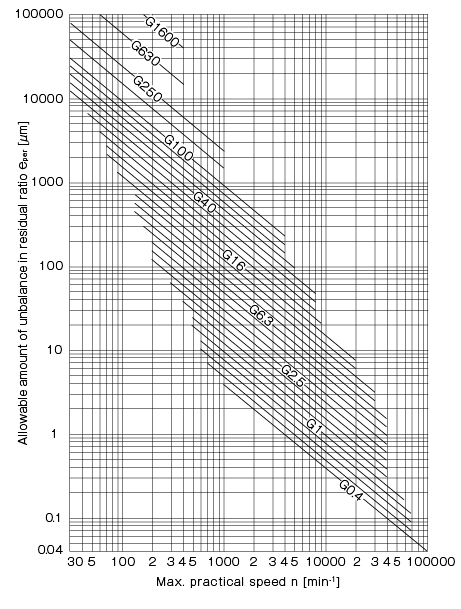Balance Quality of Rotating Equipment
According to JIS B 0153-1985, the balance quality is defined as a quantity that shows the balance of a rigid rotor and is a product between a specific unbalance and specified angular velocity.
Procedure to Determine Allowable Unbalance
The following numerical information on the rotor is needed to determine the allowable unbalance.
- Max. rotation speed at which the rotor is used:nmax
- Rotor mass:m
- Position of the rotor bearing
- Position of the correction plane
- Position of the center of mass (gravity) of the rotor
- Set the balance quality grade according to the type of the rotor. The smaller the balance quality grade value, the higher the balance accuracy. However, special attention needs to be paid to G1 and G0.4 as mentioned in the JIS text.
- Obtain the allowable residual specific unbalance eper from the max. rotation speed at which the rotor is actually used. This can be obtained by the following calculation formula or from the figure on the right.
Balance quality= e・ω
ω =2πn/60=n/9.55
n[min-1]
ω[rad/s]
ω =2πn/60=n/9.55
n[min-1]
ω[rad/s]
Balance quality=e・n
9.55
9.55
- Obtain the allowable residual unbalance from the allowable residual specific unbalance and rotor mass. Allowable residual unbalance Uper=eperm [g•mm]
- Actually allocate the allowable residual unbalance to the unbalance of the correction plane (for details, refer to the JIS text, because the allocation calculation varies depending on the relationship of the position of the bearing, the position of the correction plane, the mass, and the position of the center of the mass).

Recommended Balance Quality Grade for Each Type of Rotating Machine(JIS B 0905-1992)
| Balance quality grade | Balance quality upper limit mm/s (eper ×ω) |
Rotor type example |
|---|---|---|
| G4000 | 4000 | ● Rigidly supported crank shaft system *2 of a low-speed diesel engine *1 for vessels with an odd number of cylinders |
| G1600 | 1600 | ● Rigidly supported crank shaft of a large 2-cycle engine*2 |
| G630 | 630 | ● Rigidly supported crank shaft system*2 of a large 4-cycle engine ● Elastically supported crank shaft system *2 of a diesel engine for vessels *1 |
| G250 | 250 | ● Rigidly supported crank shaft system *2of a high-speed 4-cylinder diesel engine*1 |
| G100 | 100 | ● Six or more cylinder crank shaft system of a high-speed diesel engine*1, and complete engine (gasoline or diesel) for cars, trucks, and railway cars |
| G40 | 40 | ● Wheel, rim, wheel set, and drive shaft for cars ●Elastically supported 6 or more cylinder high-speed 4-cycle engine*1 ●((Gasoline or diesel) crank shaft system*2 ● Crank shaft system*2 of an engine for cars, trucks, and railway cars |
| G16 | 16 | ● Drive shafts with special requirements (propeller shaft and cardan shaft) ● Crusher parts ● Agriculture machine parts ● Parts of (gasoline and diesel) engines for cars, trucks, and railway cars ・ 6 or more cylinder crank shaft systems with special requirements*2 |
| G6.3 | 6.3 | ● Equipment for process plants ● Marine main turbine gears (for merchant ships) ● Centrifugal separator drums ● Papermaking rolls and printing rolls ● Fans ● Assembled aircraft gas turbine rotors ● Flywheels ● Pump impellers ● Machine tool and general machine parts ● Medium and large armatures (of power generators with a shaft center height of at least 80 mm) without special requirements ● Small armatures (mainly for mass production) that are used for vibration insensitive applications or that are vibration resistant ● Engine parts with special requirements |
| G2.5 | 2.5 | ● Gas turbines, steam turbines, and marine main turbines (for merchant ships) ● Rigid turbo-generator rotors ● Computer memory drums and disc turbo compressors ● Machine tool main shafts ● Medium and large armatures with special requirements ● Small armatures (excluding those under conditions of G6.3 and G1) ● Turbine drive pumps |
| G1 | 1 | ● Tape recorder and audio equipment rotating parts ● Grinder wheel spindle ● Small armatures with special requirements |
| G0.4 | 0.4 | ● Precision grinder wheel spindles, grinding wheels and armatures ● Gyroscopes |
*2: Crank shaft system refers to a system that includes a crank shaft, flywheel, clutch, pulley, damper, and rotating parts of the connecting rod.
* The mass of the rotor of a complete engine refers to the total mass of all parts of the crank shaft system.
Other Technical Documents
- General Tolerances(Excerpt from JIS B 0405 1991/JIS B 0419 1991)
- MIKI PULLEY Coupling Standard Hole Drilling Standards
- MIKI PULLEY Clutch and Brake Standard Hole Drilling Standards
- Frequently Used Fits
- Fitting Tolerances(Excerpt from JIS B 0401)
- International System of Units (SI)
- Hexagon Socket Head Cap Bolts (Excerpt from JIS B 1176 2014)
- Hexagon Bolts (Excerpt from JIS B 1180 2014)
- Hexagon Socket Set Screws (Excerpt from JIS B 1177 2007)
- Hex Keys (Excerpt from JIS B 4648 2008)
- Parallel Key and Keyway Sizes and Tolerances
- Retaining Ring (Excerpt from JIS B 2804 2010)
- Bearing Mounting Dimensions
 日本語
日本語 English
English Deutsch
Deutsch 中文
中文 한국어
한국어





